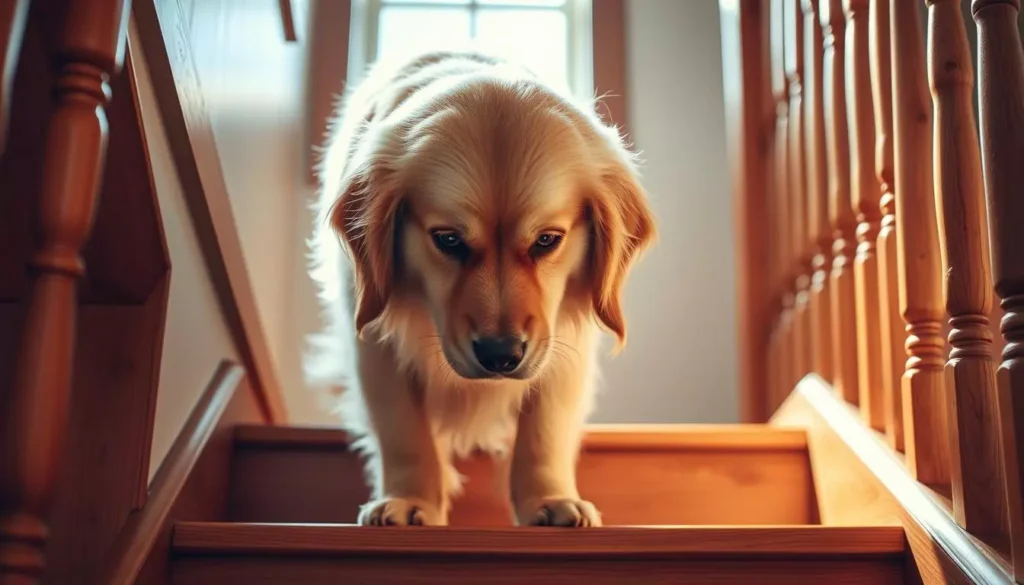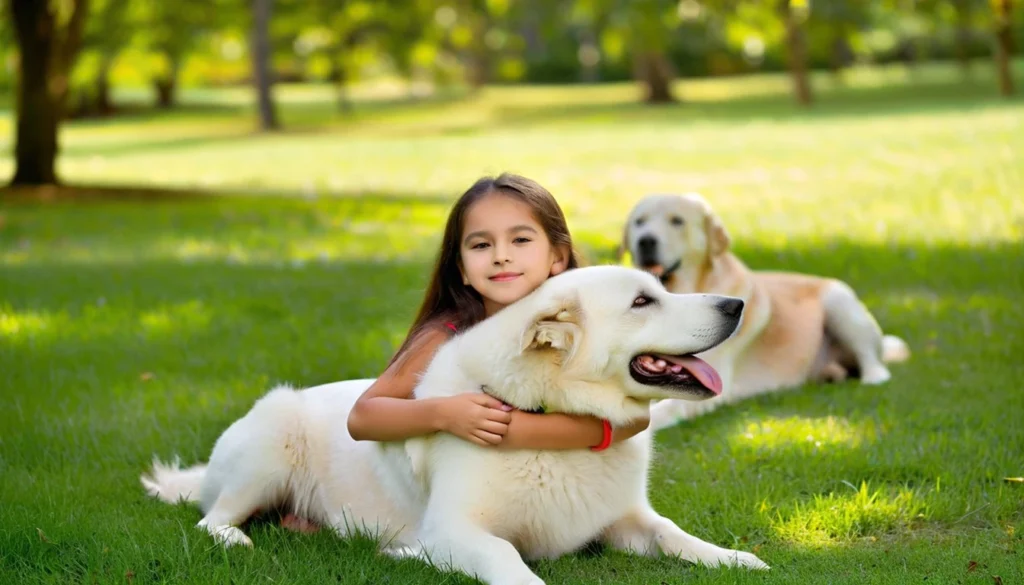Seeing my dog wag his tail fills my heart with joy. The sunlight catches in his fur as he runs to me. But, the thought of trimming his nails makes me anxious.
My first attempt at trimming his nails was tough. My hands shook, and I feared hurting him. The idea of trimming scared nails seemed like a storm cloud over me.
Trimming his nails is key to his health and happiness. It affects his comfort, walking, and overall well-being. With the right techniques, I've learned to trim his nails safely. This guide will help us both master this skill.
Key Takeaways
- Understanding the need to regularly trim dog nails is essential for their health.
- There are techniques to calm your dog during the nail trimming process.
- Choosing the right tools can make all the difference in the trimming experience.
- It’s important to know how to identify the quick and trim safely.
- Regular nail maintenance prevents injuries and improves comfort while walking.
The Importance of Trimming Your Dog's Nails
Nail trimming is key for pet owners. It keeps my dog healthy and happy. Short nails make my dog more comfortable and prevent health problems.
Benefits of Regular Nail Trimming
Trimming nails regularly has many benefits. It stops my dog from feeling pain from long nails. This makes walking and running easier.
It also helps my dog stand right, easing muscle and joint strain. Plus, it reduces the chance of nail injuries or infections.
Consequences of Overgrown Nails
Not trimming nails can harm my dog. Long nails make walking hard and can cause injuries. These injuries might need vet care.
In extreme cases, long nails can hurt my dog's feet or cause infections. This can really lower my dog's quality of life. So, regular nail trimming is crucial for my dog's health.
Preparing for the Nail Trim
Getting ready is key for a smooth nail trim. I start by collecting the right tools to make it easier and less stressful. I have dog nail clippers or grinders, a nail file, and styptic powder for any bleeding.
Gathering the Right Tools
I look for quality and safety when picking tools. Using top-notch clippers like the Safari Nail Trimmer or the Dremel PawControl Nail Grinder is important. These tools are made for dogs and help avoid hurting them.
Choosing the Right Location
Then, I pick a good spot for trimming. A bright and quiet place is best. I choose a spot where my dog feels safe and calm, which helps a lot.
Creating a Calm Environment
To keep things calm, I use a few tricks. I give treats or positive words during the process. Soft music or a favorite blanket can also help a lot. These steps help me deal with the challenge of trimming my dog's nails, making it better for both of us.
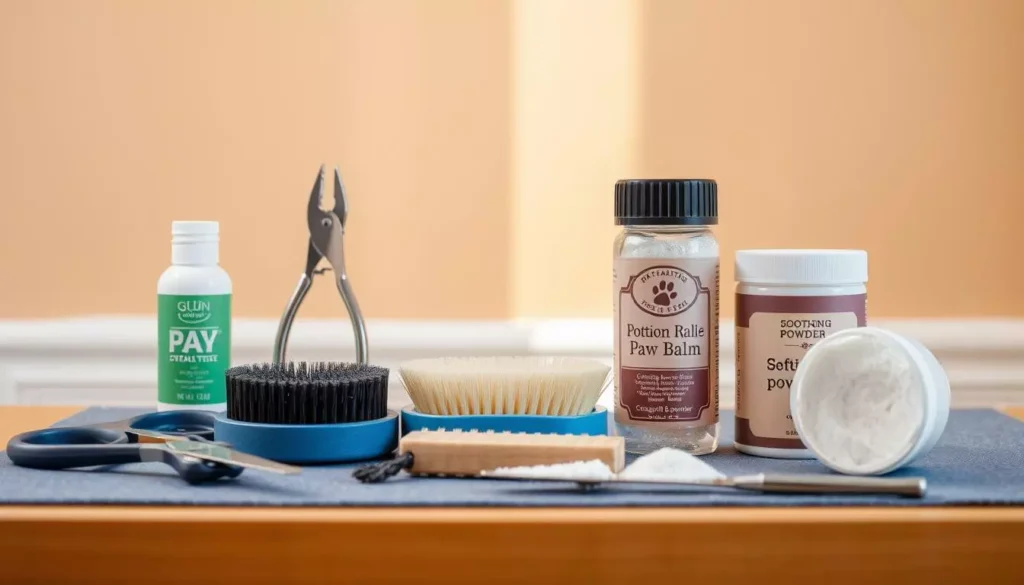
Getting Your Dog Comfortable With Nail Trimming
Learning to trim your dog's nails needs preparation and positive feedback. First, make a safe and calm space for your dog. This makes the nail trimming less stressful for both of you.
Acclimating Your Dog to Having Their Paws Handled
Building trust starts with simple steps. Start by gently touching their paws and praising them. Gradually increase the time spent on paw handling. This helps your dog get used to paw touching, making nail trimming easier.
Introducing the Nail Clippers or Grinder
After getting comfortable with paw handling, introduce the nail clippers or grinder slowly. Let them sniff and get used to the sounds. Treats and praise help create positive feelings, reducing fear.
These steps help build trust and make nail trimming easier. Preparing well ensures your dog is calm during nail care.
How to Trim Dogs Nails: Step-by-Step Guide
Trimming my dog's nails is a task that needs careful attention and practice. I make sure the process is smooth for both of us. The right way to cut dog nails involves holding the paw correctly, finding the quick, and using the right trimming technique.
Holding the Paw Correctly
When I hold my dog's paw, I do it gently yet firmly. I put my thumb on the pad of one toe and my forefinger on the top. This makes it easier to see and trim the nails effectively.
Identifying the Quick
Identifying the quick is key when trimming my dog's nails. For light-colored nails, the quick is a pink area. In darker nails, it's a darker section. Knowing this helps me trim overgrown nails safely.
Proper Trimming Technique
I trim at a 45-degree angle, cutting only the tip of the nail. This avoids hitting the quick and keeps my dog comfortable. Using this method consistently makes nail trimming safe and successful.
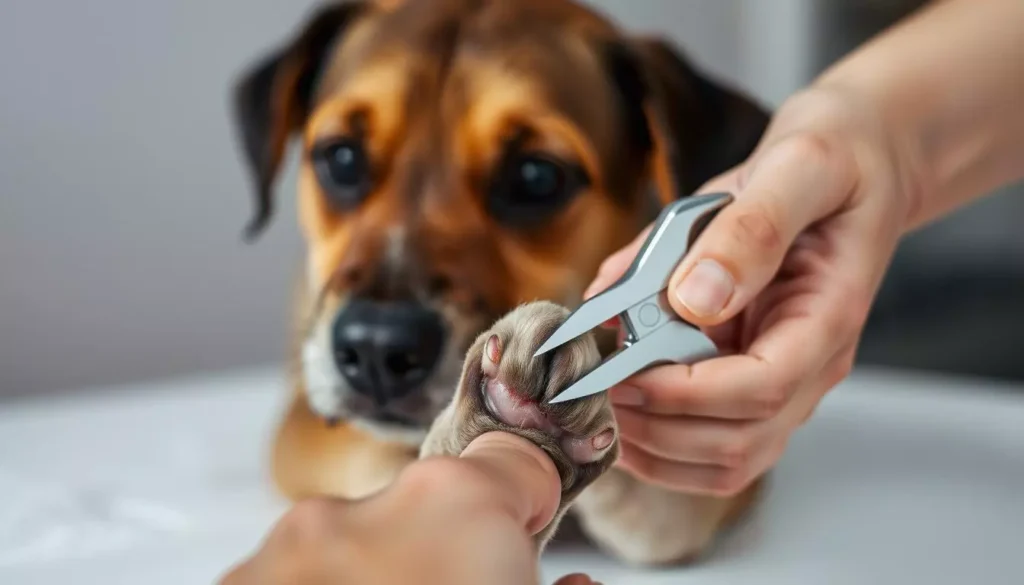
Types of Dog Nail Clippers and Grinders
Choosing the right tools is key when cutting a dog's nails. There are many types of clippers and grinders for different breeds and sizes. Knowing these options helps make nail trimming easier for both dogs and their owners.
Scissor Clippers
Scissor clippers are great for smaller dogs. They look like scissors and allow for precise cuts. They are easy to use and don't put too much pressure on the nails.
These clippers are also light and easy to handle. They're perfect for beginners.
Guillotine Clippers
Guillotine clippers are better for larger breeds. They are plier-style and strong. This design lets you apply enough force for a clean cut.
They offer stability and efficiency. This makes them a good choice for confident nail trimming.
Nail Grinders
Nail grinders are a different option from clippers. They file down nails gently, which can be less scary for dogs. They give a smooth finish.
However, they can be noisy. This might upset anxious pets. I think about my dog's personality when deciding between clippers and grinders.
How to Read Your Dog’s Nail Color
It's important to know how to read your dog's nail color for safe nail trimming. The color tells you where it's safe to cut, especially when finding the quick. This is the sensitive part of the nail with blood vessels and nerves.
Identifying the Quick in Light-Colored Nails
Light-colored nails make it easy to spot the quick. You'll see a pink area inside the nail. Trim the tips carefully to avoid this area. This way, you can trim without hurting your dog.
Identifying the Quick in Dark-Colored Nails
Dark-colored nails are trickier to figure out. Look for a chalky white ring around the nail. This means you're getting close to the quick. When trimming black nails, cut slowly and watch the nail closely. This helps avoid cutting too deep and hurting your dog.
In short, knowing how to read your dog's nail color makes nail trimming safer and easier. Whether the nails are light or dark, being careful about the quick makes the experience better for both you and your dog.
Techniques for Anxious Dogs
Nail trimming for anxious dogs can be tough for both you and your pet. It's key to be patient and understanding. Using calming techniques and positive reinforcement can help your dog relax.
Calming Techniques Before the Trim
Creating a calm space is vital. I start with gentle activities like petting or playing with a favorite toy. Calming scents, like lavender, can also help.
A cozy spot with soft bedding makes your dog feel safe and calm.
Positive Reinforcement Strategies
Positive reinforcement is crucial during nail trimming. I reward my dog with treats, cheers, and praise for good behavior. This makes them look forward to nail trimming.
Trimming Tips for Puppies
Puppies need special care when it comes to their nails. Getting them used to nail care early is key. I suggest starting nail trimming early to help them get used to it.
When Can Puppies Get Their Nails Trimmed?
Puppies can start nail trimming at three to four weeks old. This early start helps them get used to it without stress. It's important to be gentle and make each session calm and positive.
Tips for Filing Puppy Nails
For filing puppy nails, a gentle nail file works best. Be careful not to hurt the quick. Here are some steps to follow:
- Start small to avoid upsetting your puppy.
- Try different files to see what works best for your puppy.
- Stay calm. If you're relaxed, your puppy will likely feel the same.
- Give treats and praise after filing to make nail care a positive experience.
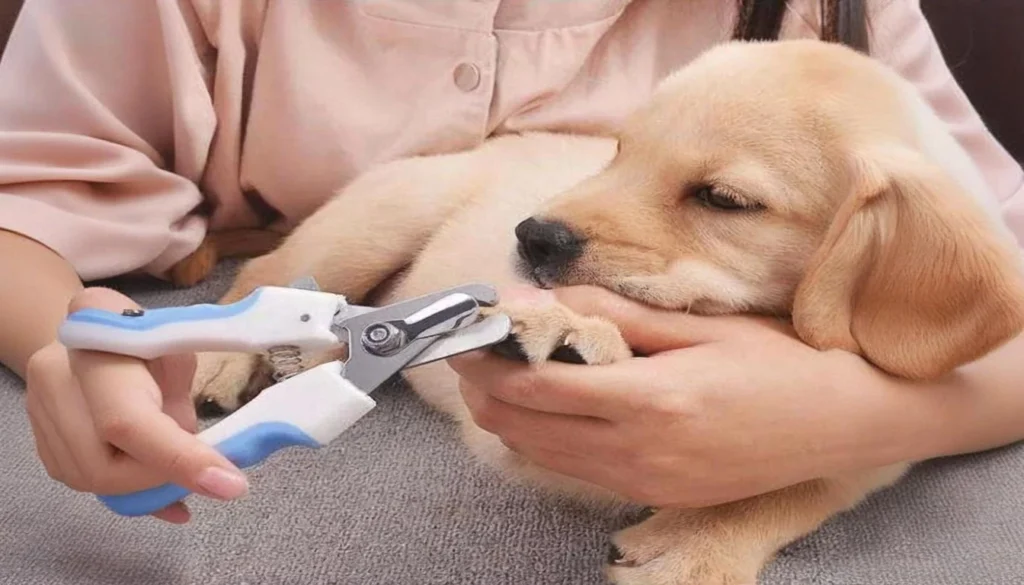
Maintaining Your Dog's Nails Between Trims
Keeping my dog's nails in good shape is key. I look for ways to keep their nails short without clipping. This helps their comfort and health. I stick to a few important practices to keep their nails right.
How to Keep Dog Nails Short Without Clipping
Walking my dog on hard surfaces is a natural method I use. It helps wear down their nails and prevents overgrowth. It's a simple yet effective way to keep their nails in check.
I also watch how often we walk on these surfaces. It greatly affects their nail maintenance.
Using a Nail File on Overgrown Nails
When my dog's nails get too long, I use a nail file. It smooths out rough edges and manages lengths safely. I file each nail gently, which is calming for both of us.
Regular filing helps my clipping sessions and keeps their nails in good shape.
What to Do If You Cut the Quick
Accidents can happen, and cutting the quick during a nail trim is stressful for both me and my dog. It's crucial to know what to do if you cut the quick. I focus on immediate actions to manage the situation well.
How to Manage Bleeding
When I cut the quick, my first action is to apply styptic powder to the nail. This powder helps clot the blood and stop the bleeding fast. If I don't have styptic powder, flour can be a temporary fix.
It's key to watch my dog closely during this time. If the bleeding doesn't stop or gets worse, I note it and plan to see a vet.
When to Seek Veterinary Help
It's important to know when to get veterinary help for severe bleeding. If the bleeding doesn't stop after a few minutes of using styptic powder or flour, I call my vet right away. I also watch for signs of distress in my dog, like panting, whining, or licking at the wound.
| Action | Description |
|---|---|
| Apply Styptic Powder | Quickly apply to the nail to help stop the bleeding. |
| Use Flour if Needed | A temporary solution if styptic powder isn't available. |
| Observe the Dog | Monitor for excessive bleeding or signs of pain. |
| Contact Vet | Seek help for persistent bleeding or visible distress in my dog. |
The Right Frequency for Nail Trimming
Finding out how often to trim your dog's nails is important. Each dog is different, and things like breed and how active they are matter. Most dogs need a trim every four to six weeks. This keeps their nails short and helps them stay healthy.
Evaluating How Often to Trim Nails
Watching how your dog moves helps figure out when to trim their nails. Dogs that walk a lot on hard ground might not need trims as often. But dogs that stay inside on carpets might need them more.
Looking at their nails can tell you what they need.
Signs Your Dog's Nails Are Too Long
Knowing when your dog's nails are too long is key. Here are some signs:
- The sound of nails tapping on hard surfaces while they walk.
- Difficulty in walking or playing, leading to unexpected slips.
- Visible discomfort or reluctance when engaging in regular activities.
| Signs Your Dog's Nails Are Too Long | Possible Solutions |
|---|---|
| Tapping sounds on hard surfaces | Schedule a nail trim |
| Difficulty walking or playing | Use regular trimming every 4-6 weeks |
| Visible discomfort during activities | Evaluate nail length frequently |
Common Mistakes to Avoid
Nail trimming can seem simple, but many make mistakes. These errors can make the process safer and more enjoyable for both me and my dog. Two big mistakes are rushing and forgetting about dewclaws.
Rushing the Process
Rushing is a big mistake in nail trimming. It can lead to accidents or stress for my dog. Each nail needs careful attention to avoid cutting too deep.
This careful approach prevents bleeding and keeps my dog calm.
Neglecting the Dewclaws
Forgetting dewclaws is another common mistake. These nails need just as much care as the others. If I ignore them, they can grow too long and cause pain.
Regularly checking and trimming all nails, including dewclaws, keeps my dog healthy and pain-free.
Knowing these mistakes helps me trim nails with confidence and care. By not rushing and paying attention to dewclaws, we both have a better experience.
How to Trim Your Dog’s Nails at Home
Trimming my dog’s nails at home can seem scary at first. But, setting a regular schedule makes it easier. This way, my dog gets used to it, and we both feel more at ease.
Setting a Routine for Nail Trimming
Creating a consistent routine is key. Regular trims help my dog know what to expect. I trim their nails every two to four weeks, depending on growth.
Sticking to this schedule makes my dog less nervous. This makes each trim easier for both of us.
Tips for a Successful Home Grooming Session
To have a successful grooming session at home, I follow a few important steps:
- Prepare the environment: I pick a quiet spot without distractions. This keeps my dog calm.
- Gather the right tools: Having the right clippers or grinder ready saves time and stress.
- Use positive reinforcement: I give my dog treats and praise during and after. This makes them look forward to it.
- Enlist help when needed: If my dog gets upset, having someone to hold them helps a lot.
By sticking to a routine and using these tips, I can confidently trim my dog’s nails at home. It’s a stress-free experience for both of us.
Conclusion
Learning to safely trim dog nails is key for pet owners. It keeps their pets healthy. By doing it right, I avoid painful nail growth and help my dog feel better.
Getting ready is important for a good nail trim. I make sure I have the right tools and a calm place. Knowing what makes my dog comfortable helps us both relax.
If I'm unsure, I ask a vet or groomer for help. This makes me feel more confident in my nail care skills. It also strengthens our bond.


